Top 5 Storytelling Recommendations For Your Script
Posted: April 19, 2023 | Updated: April 24, 2023
Posted In: Articles
If there was a magic formula for script writing to predict the future success of a film or T.V. show, every entertainment executive in the world would want to get their hands on it.
Unfortunately, even the most successful screenplay writers will tell you that there is no single formula, secret sauce, or one-stop guideline to ensure a box-office hit.
The defining qualities that make certain films or shows stick in our brains more than others is highly subjective, unpredictable and greatly varied depending on the viewer and their distinct interests at the time.
At the end of the day though, humans are more similar than what we might think. We want the same things (comfort, security, involvement, entertainment) and we can address those needs in many different ways – whether that’s through watching flesh eating zombies, steamy romances filled with forbidden love, or talking animals.

Even though these types of content vary in terms of the themes they present to the audience in a particular scene, how long they last, and what their genre is, a successful script has a series of fundamental components that promote viewer engagement and ultimate success. Read about this theory in more detail in this article.
How does this contribute to originality and script creativity?
If every script has the same basic outline, wouldn’t audiences pick up on that and start to become uninterested (the, “we’ve seen it all before” tagline)?
The simple truth is that while creativity and originality are essential aspects of scriptwriting, it’s equally important to ensure your story follows a well-structured plot and is supported by strong character development. Originality is built on-top of these factors. Picture a hamburger bun without the hamburger patty itself, it wouldn’t make sense right?
As a writer, crafting a compelling and engaging story is a cumbersome task that requires a deep understanding of the art of storytelling. Writers have their own artistic vision or super objective for how they want to see their stories brought to life, but in order to do this, they need reliable and trustworthy components to ensure their audience will listen.
What’s the best way to do this? Script Analysis!
Script Analysis is the process of breaking down a screenplay to understand its fundamental elements (plot, character arcs, character’s objective, themes, significant words, and motifs). Through analyzing these components, you can identify the strengths and weaknesses of your story and make necessary adjustments to improve its overall quality.
At StoryFit, we measure thousands of scripts against millions of data points to simulate how audiences will respond to stories. Through this process, we are able to identify which components make or break a story and how to amplify your script’s true value to place it in front of the right audience – story intelligence made simple.

StoryFit’s AI script analysis engine has analyzed thousands of groundbreaking and highly acclaimed stories to narrow down our top 5 storytelling recommendations to ensure success.
Curious what they are? Let’s get into it!
Recommendation #1 – Have a Core Set of Narrative Elements
Why is narrative so important? As one of the most vital elements to a script, it serves as the backbone for which every other element is built off of. Narrative elements anchor the story, and it’s in this realm where the film or series will first connect with audience expectations. It’s also here where a unique combination of narrative elements can be genre-bending and memorable. That’s why it’s so important to identify the set of narratives that define your story.
It is essential for developing well-rounded and memorable characters and allows for character development and growth over the course of the story, as other characters face obstacles, make choices, and experience change. It can create a sense of tension, mystery, or excitement, depending on the genre and themes of the script, immersing the audience in a particular world and creating a sense of realism and authenticity in every beat change.
Narrative refers to the way in which a story is constructed, the way events unfold, and the way characters interact with each other. Without a strong narrative, a script can quickly become disjointed, or confusing for the viewer.
Audiences recognize a strong narrative when they see one, and structure and coherence correlates to understanding and engagement (from beginning to end).
StoryFit’s script analysis de-compartmentalises narratives into “story metrics,” which are defined as elements that an audience member recognizes through their own interpretation of the script.
Here are a couple of examples of story metrics that help to categorize a narrative:
- Abuse
- Action-Packed
- Belonging
- Bravery
- Feel-Good
- Justice
- Heart Pounding
- Multi-Layered Plot
- Zany
Successful scripts will index highly or prominently (within the top 10% of 25% of the genre) in story metrics that define its narrative.
For instance, a reputable drama about sexual assault would likely index high in story metrics like these: Abuse, Justice, Discrimination, Thought-Provoking, or Heart Pounding.
In the same way that script analysis can identify a strong narrative from its high incorporation of valuable story metrics, it can also pinpoint when a script is lacking in essential elements.
Amsterdam, a 2022 Comedy-Drama film directed by David O’Russel, is a great example of this.
The movie, which was projected to be a box office hit, had all the right ingredients for success: an Oscar-winning production team, a starry cast with big-name celebrities, an $80 million budget, and an awards-friendly “based on a true story” premise.
But the film only made $31 million worldwide, and scored just 32% on Rotten Tomatoes. Why did the script flop? The answer can likely be found through a script analysis of its narrative.
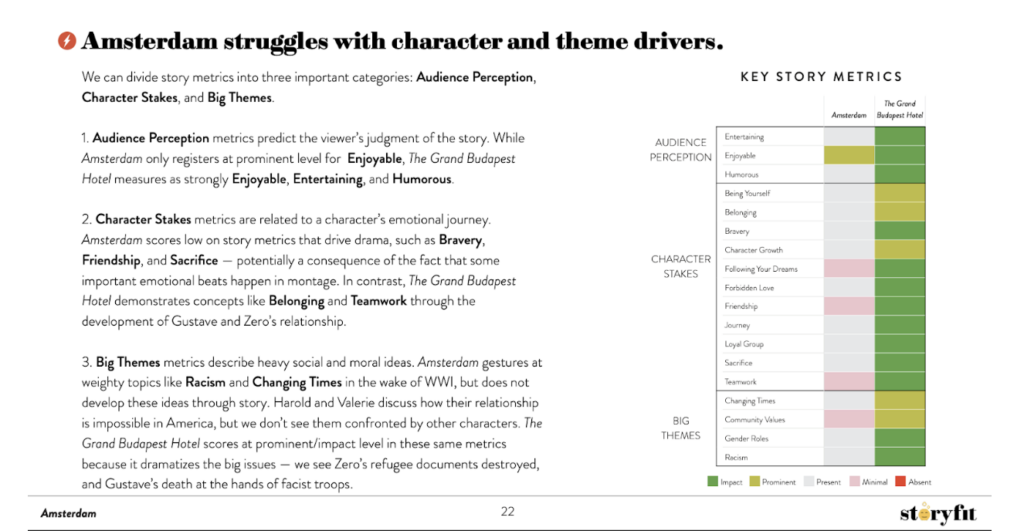
While it checked a lot of boxes from an entertainment executive standpoint, the narrative seemingly struggled with definition and story themes.
Through StoryFit’s AI analysis, we broke up the narrative into three important components:
- Audience Perception (predicted viewer’s judgment of a story)
- Character Stakes (the character’s motives or emotional journey within the story)
- Big Themes (larger plot takeaways for the audiences to recognize)
As you can see from the script analysis, Amsterdam struggled in all three of these categories when compared against the award-recognized screenplay, The Grand Budapest Hotel.
Not only did it falter in the Audience Perception category (indexing prominently for only the Enjoyable story metric), its characters lacked definition.
Amsterdam also struggled with topical themes that were intrinsic to the historical context of the film. Weighty story metric topics like Racism and Changing Times only index as average, and are not further developed throughout the story. The Grand Budapest Hotel scores at prominent/impact level in these same metrics because it dramatizes the big issues at play (audiences see a lead character’s physical documents destroyed and a character death at the hands of fascist troops).
Audiences know the difference between watching a story and feeling immersed in it, which is why narrative is so important.
Recommendation #2 – Develop a Prominent Story Arc
We might think this one is a given. What film doesn’t have rises and falls within the plot to garner an emotional response?
While it may be true that almost all stories experience a tonal change at one point or another, it matters how distinguished that change is for viewers.
Our script analysis recognizes story arcs in a number of ways. StoryFit’s story intelligence process utilizes scene-by-scene pacing technology to monitor rises and falls within the plot line, delivering accurate projections of where specific tonal metrics like New Complications, Suspenseful, or Things Got Worse register at different points in the screenplay.
Cliffhangers are typically utilized in action-oriented or suspense thrillers to peak audience interest and hold them on the edge of their seat. Analyzing the final five scenes of a pilot or movie is a proficient way of measuring this element.
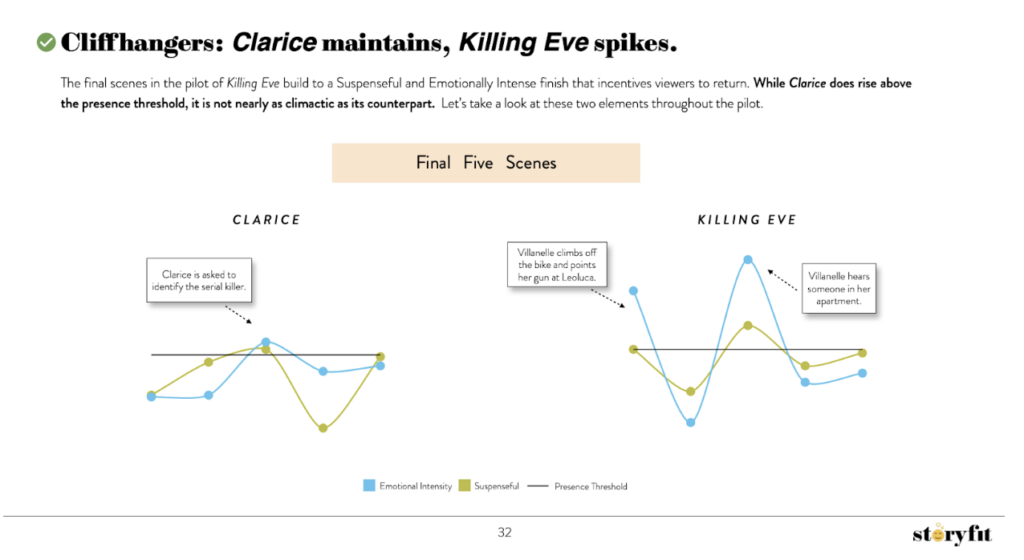
Looking at the Cliffhanger metrics for two Crime-Drama-Mystery pilots, Clarice and Killing Eve, it’s no secret which one was a success and which one fell flat.
Where Clarice registers barely above the presence threshold (a marker for viewer awareness of the story element) for two Cliffhanger elements like Emotional Intensity and Suspenseful, Killing Eve knocks it out of the park, delivering multiple spikes well above the presence threshold to keep viewers highly invested in the story.
While it’s not as important that the story ends on a high note, great stories have dramatic moments like this to heighten the character stakes and incentivize viewers to return for more.
StoryFit also measures the story arcs made famous by Kurt Vonnegut. This idea theorized that there are specific archetypes story maps tend to fit into, which includes: Rags to Riches, Riches to Rags, Man in a Hole, Oedipus, Icarus, and Cinderella.
Following Vonnegut’s lessons about the significance of mapping the ups and downs of plot arcs, you will find a “Cinderella story” in the movies you’d least expect! Learn more about this in our article, “Vice is a Cinderella Story?”.
Recommendation #3 – Incorporate Emotional Intensity Throughout
Emotional Intensity is often referenced by both critics and viewers as a common characteristic for great stories, but rarely is it precisely measured. What is it exactly and why is it so important?
The metric refers to the level of a viewer’s engagement or attachment to a story at a particular moment or time. High Emotional Intensity correlates strongly with high viewer interest, making this an indispensable element to predict success.
Keep in mind, emotionally intense screenplays often have many peaks and valleys – moments that spike above and below the presence threshold. Rises and falls in emotional intensity add to the overall suspense and audience investment, working to create tension throughout.
Let’s examine this metric by looking at two popular award-winning films’ levels of Emotional Intensity.
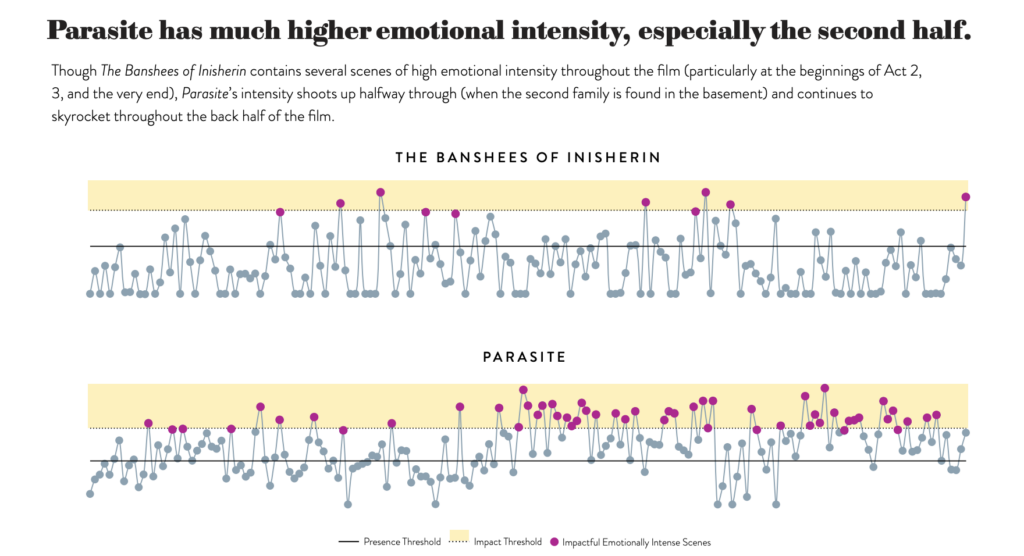
If you’ve seen Parasite, you know that it continuously keeps audiences gasping for breath in the given circumstances of the plot.
StoryFit’s script analysis engine registered Parasite as having dozens of emotionally intense scenes reaching the impact level, particularly in the second and third act when the second family is found in the basement of the house.
Although The Banshees of Inisherin demonstrates several moments of intensity as well, audiences respond better to more frequent prompts for engagement.
Recommendation #4 – What’s a story without a good old-fashioned character evolution?
One key component that many successful screenplays share is their ability to create complex, interesting, and ever evolving characters.
Compelling characters are not always likable, in fact oftentimes it’s the most flawed, greedy, or brutal characters that viewers remember and hold on to within a narrative.
This allows for more nuanced storytelling, as their motivations and actions are not easily predictable and their character journeys speak to the uniqueness of the writer and their implied creativity.
To learn more about character analysis and the ways that AI enriches this process along with script analysis, read this article.
One of the most noteworthy and complex characters ever created for T.V. was Walter White, a highly skilled chemist turned high school teacher who begins selling methamphetamine with a student when he is diagnosed with cancer.
His character evolution is a model example of how a writer can apply character traits to effectively progress a lead’s journey through the course of a season.
Audiences don’t want to be overloaded with all the “perfect” character traits when first getting introduced to a character, but rather witness how a lead’s motives and drivers develop over time (in other words, be taken along for the ride with them).
A character analysis of this journey is a great way to witness the evolution of traits from a data standpoint.
If you take a look at the chart below, Walt’s characteristics are placed into three categories:
- Appeal
- Ability
- Complexity
In each of these categories, a clear story is being told. Walt captivates us with his compelling traits in the pilot, with consistent markers that maintain audience interest and “forgiveness (Likable, Authentic, Competitive).
While some of his traits devolve, this is crucial to his Season 1 journey as a whole. For example, he becomes less Anxious and Physically Violent over time, but ends strongly with Bold, Courageous, Extraverted qualities – characteristic of a Leader.
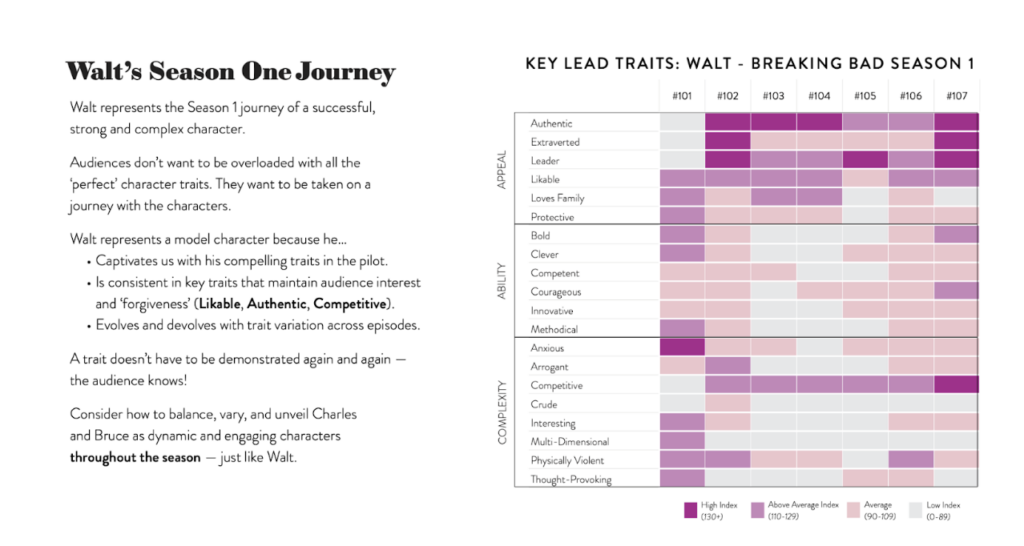
Recommendation #5 – Demonstrate Relatability
Character relatability is a crucial element in any form of storytelling and incentivizes audience empathy and understanding. As viewers, we get to see how these characters’ motivations, desires, and struggles affect their actions and decisions, providing insight behind why they might go to some of the lengths they do.
In certain ways, these qualities help them to become more flawed or “human,” and we are as a result, able to see ourselves through their characters and their significant beat changes.
This connection can serve as a source of comfort and validation for the audience. A relatable character acts as a mirror. When we witness varied challenges and emotions that we have personally experienced, it can help us feel less alone in our own struggles.

Viewers gain insight into how to deal with issues by observing how the character copes with theirs (and the way in which their methods may fail).
No one wants to watch a one-dimensional lead. The level of vulnerability a lead shows within a script strengthens complexity and maximizes engagement. Their interactions with other characters in the story display this as well.
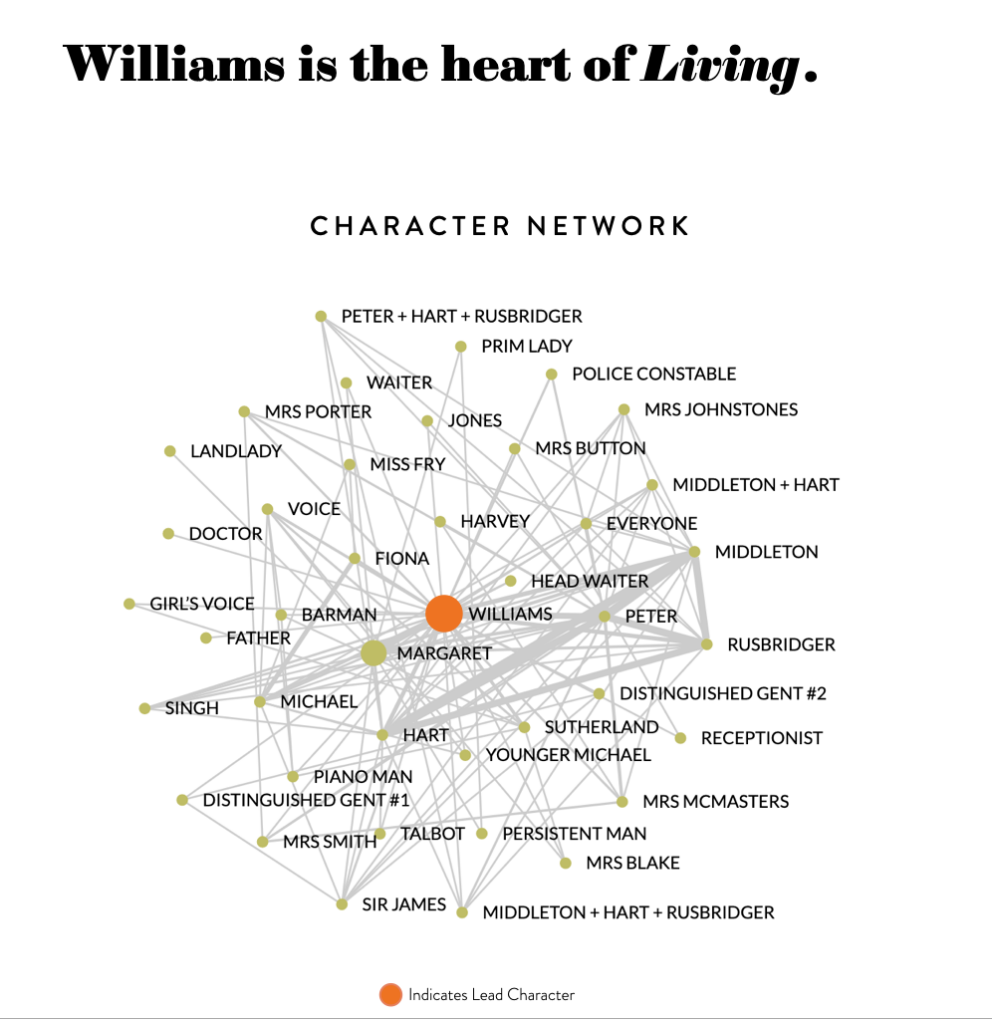
Our Character Network graphic displays the prominent relationships characters have with one another through their connected lines. The darker the line, the stronger the connection (the more audiences will view their relationship as significant).
In Conclusion
There is no one right way to successfully write a script, and if there was, the great ones would eventually become mundane.
However, prioritizing these top 5 storytelling recommendations will lay the groundwork for greatness.
- A sufficient story narrative
- A clear character arc
- Strong levels of emotional intensity
- A prominent character evolution
- Character relatability
Have a script but not sure what your next steps should be? StoryFit can help with your script analysis needs!
